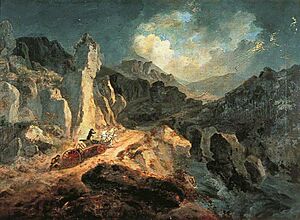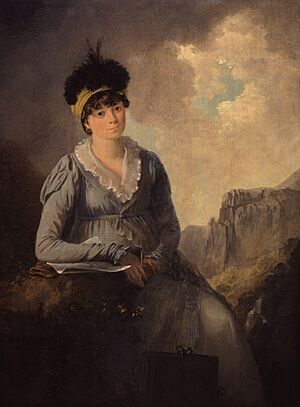Julius Caesar Ibbetson facts for kids
Quick facts for kids
Julius C. Ibbetson
|
|
|---|---|

Selfportrait of Julius Caesar Ibbetson, 1804
|
|
| Born | 29 December 1759 |
| Died | 13 October 1817 |
Julius Caesar Ibbetson (born December 29, 1759 – died October 13, 1817) was a talented British artist. He lived in the 1700s and was known for his beautiful landscape paintings and watercolour art. He painted many different scenes, from quiet countryside views to busy industrial areas and dramatic shipwrecks.
Contents
Early Life and Learning to Paint
Julius Caesar Ibbetson was born in Farnley Moor, near Leeds, England. He was the second child in his family. His mother had an accident, and he was born early. This is how he got his middle name, Caesar, though he tried to keep it a secret!
Julius probably went to school with the Moravians and Quakers in Leeds. These schools gave him a very good education. This helped him write clearly in his painting guides and in his fun letters to people who supported his art. From 1772 to 1777, he learned to paint ships in Hull. After that, he moved to London. For ten years, he mostly worked on fixing old paintings. Around 1780, he married his first wife, Elizabeth.
Becoming a Famous Artist
First Art Shows and Important Works
In 1785, Ibbetson started showing his paintings at the Royal Academy. One of his first known paintings, George Biggin (1783), was a very good portrait. It showed how talented he was, even though he taught himself to paint.
In 1787, he got a special job. He became the artist for a British trip to Peking (now Beijing). He drew many animals and plants he saw on the journey. While he was away, his painting Ascent of George Biggin, esq. from St. George's Fields, June 29th 1785 was shown. This painting showed a hot air balloon taking off in London. People loved it!
Later Paintings and New Friends
In 1789, Ibbetson visited Cardiff Castle in Wales. He spent many years drawing the amazing scenery there. His detailed watercolours of iron factories and coal mines are important records of early industry in that area. He also painted many scenes of everyday life and beautiful landscapes.
After visiting the Isle of Wight in 1790, he started painting shipwrecks and smugglers. In 1794, he was hired to decorate Kenwood House. This helped him during a very sad time after his wife passed away. He also had three children to care for.
Four years later, he moved to Liverpool to work for Thomas Vernon. In 1801, he married his second wife, Bella Thompson. They lived in Ambleside and became friends with famous writers like William Wordsworth and Samuel Taylor Coleridge. You can even see some of Ibbetson's paintings at Dove Cottage, where Wordsworth lived.
Ibbetson found many kind people in Liverpool and Edinburgh who supported his art. One of them encouraged him to write a painting guide called An Accidence, or Gamut, of Painting in Oil (1803). In 1803, he met William Danby, who was a generous person from Yorkshire. In 1805, Ibbetson moved to Masham to be closer to him. The next 14 years were the most peaceful time in his life.
Death and Lasting Impact
Julius Caesar Ibbetson passed away on October 13, 1817. He was buried in the churchyard of St Mary's Church in Masham.
Another famous artist, Benjamin West, called Ibbetson the "Berchem of England." This was a compliment, comparing him to a great Dutch landscape painter. People admire Ibbetson's watercolours for their delicate details and clear lines. Many of his works were made into prints for books and art galleries.
Images for kids







